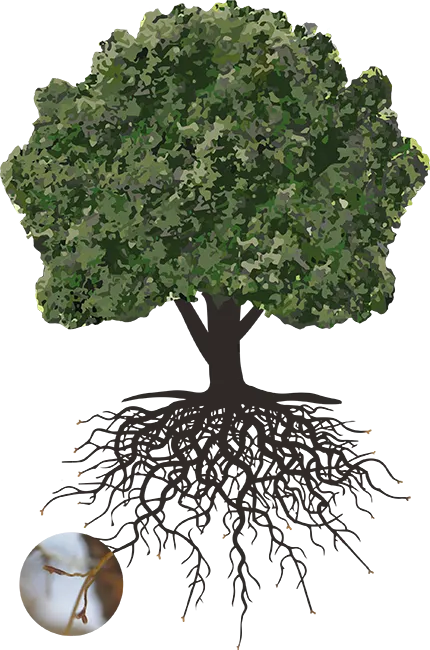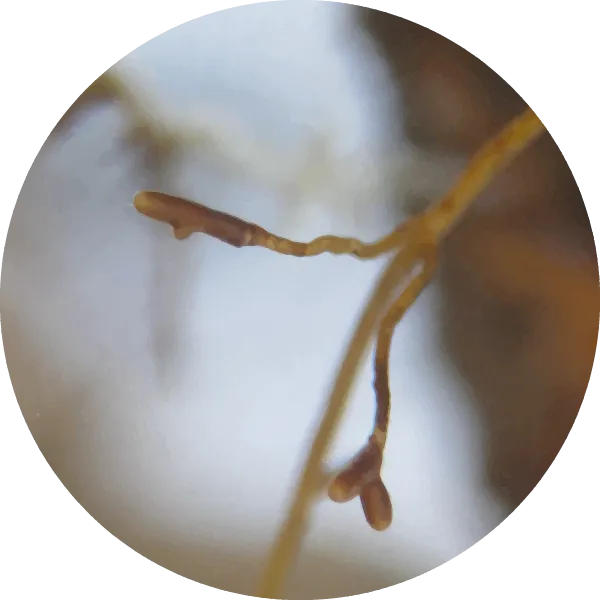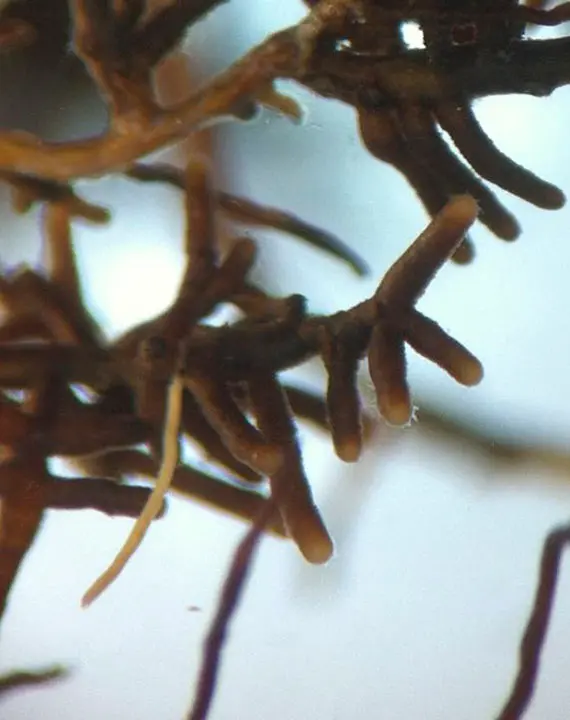The mycorrhizae that are interesting to us in truffle cultivation are called ectomycorrhizae. They are special fungal structures that develop in the root tips of trees and bushes.
These structures are composed by fine threads of fungal cells called hyphae. These treads from the fungus wrap themselves around the root tip (and in between surface root cells) thus making the tips look different: swollen and with different surface textures and colors.
This combination of root tips and hyphae is actually a symbiotic association called mycorrhiza. It is symbiotic as both fungus and plant obtain benefits from it. The fungus is not capable of photosynthesis so the plant provides it with sugars (carbohydrates). The fungus in return provides the host plant with more water and makes mineral ions like phosphorus available.
Black and summer truffles are really the fruiting bodies(mushrooms) produced by the truffle fungus associated to the plant in order to reproduce (by spores). So, without mycorrhizae there will never be truffles. For truffle production truffle mycorrhizae have to be present in the host tree roots.


For this reason, nurseries sell plants with their roots colonized by mycorrhizae of black truffle (Tuber melanosporum) or summer truffle (Tuber aestivum and Burgundy truffle or Tuber uncinatum). Some nurseries also sell plants with mycorrhizae of porcini (Boletus edulis) or saffron milk caps (Lactarius deliciosus).
HOWEVER, the truffle farmer has to be certain that the seedlings have enough truffle mycorrhizae so that they will survive and develop in the plantation. This is due to the fact that in the field the truffle fungus has to compete with other mycorrhizal species in the soil and that some of the truffle mycorrhizae may die after transplanting. It is also basic to have seedlings without high percentages of other contaminant mycorrhizal species that may compete afterwards in the orchard and endanger the future production. This is especially important in the case of Tuber brumale, Trichophaea woolhopeia or Hebeloma spp.

SUITABLE SOIL, CLIMATE AND OTHER FIELD CONDITIONS
MicoLab can manage your soil analysis and will make sure the climate, soil properties and other parameters (slope, preceding plant species in the fields, etc.) are suitable for high truffle production.
ADEQUATE HOST SPECIES
MicoLab will advise you on which tree or bush species are optimal for your field conditions.
SEEDLINGS PROPERLY COLONIZED
MicoLab will evaluate the truffle seedlings to make sure they have enough truffle mycorrhizae and that the species and amounts of contaminant mycorrhizae present (if any) will not endanger your future yields. MicoLab will also evaluate the seedling health and quality necessary to survive transplanting and grow vigorously in the fields.
PROPER PLANTATION MANAGEMENT
MicoLab will provide you with consultancy services to establish your plantation and manage it to get an early, stable and high truffle production.
MONITORING THE FIELD MYCORRHIZA STATUS
MicoLab can sample your orchards for roots to evaluate the amount of mycorrhizae in young and productive plantations and advise on improvement techniques if necessary.

Quality evaluation of nursery plants colonized by truffle species
Monitoring of the mycorrhizal status in plantations
Assessment of site suitability for truffle production
Technical training courses for farmers and analysts
Counseling on plantation establishment and improvement of existing plantations
¿Necesitas ayuda?